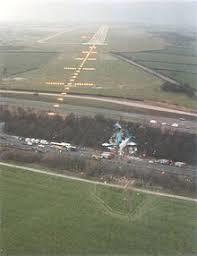What Happens When Your Pilots Shut Down Your Only Good Engine?

Got your attention?
Yes. It happened. It is one of seven disasters covered in Stuff Doesn’t Just Happen: The Gift of Failure.
That’s the plane in the image. Just short of the runway. They almost made it. And if one of the passengers had spoken up, they would have.
Passenger on British
Midland Flight 92 reflecting on hearing the pilot announce he was shutting down
the right engine: “We were thinking: ‘Why is he doing that?’ because we saw
flame coming out of the left engine. But I was only a bread man. What did I
know?”
We put our trust in experts every
day. We trust the car we drive will work. The crew of the space shuttle put its
trust in the engineers who designed it. A soldier trusts his weapon will fire. Often
we put our trust and our lives directly into the hands of experts, such as when
we board an airplane. We trust that the people who designed and built the plane
knew what they were doing and did it right. We trust that the mechanics who
worked on the plane, did so correctly. And we particularly trust that the pilot
is a professional.
We believe that the pilots know
what they are doing and are well trained. That they will react properly in
emergencies. That we shouldn’t interfere with their judgment. After all, what
do we know about flying a plane?
Every one of us has been in a
situation where we over-rode our common sense in deference to an expert. It can
be as simple as a repairman telling us something needs to be fixed, when we
really believe they aren’t going to fix the right thing. Or that the chef
undercooked our meal. But how often do we speak up?
When we put our lives in the hands of experts, and common sense says they are making the wrong decision, it’s time to speak up. Even if, as is likely, we’re wrong. Because once in a while, they’re wrong.
The Facts
On 8 January 1989, a Boeing 737-400 crashed just short of
the runway near Kegworth in the UK. 47 people were killed and 74 received serious
injuries out of a complement of 126 on board.
Shortly after taking off and
passing through 28,300 feet en route to a cruising altitude of 35,000 feet, a
blade detached from the turboprop in the left engine. It resulted in a jolt and
a bang. This was followed by a pounding noise, vibration, and smoke coming into
the cabin. Several passengers near the rear of the plane noted smoke and sparks
coming out of the left engine.
For reasons discussed below, the
pilot shut down the plane’s right engine; the wrong engine. The vibration and
smoke decreased and they descended to make an emergency landing at East Midland
Airport.
Just short of the runway, the
vibration and smoke returned as power was increased to the left engine for
landing and that engine ceased operating. The crew attempted to restart the
right engine using airflow, but because they were getting ready to land, the
plane was flying too slow and too low for this to work.
The plane crashed a quarter mile from the edge of the runway.

For an examination of the Cascade Events that went wrong leading to the crash, you’ll have to check out the book. I do give away the examination of what went wrong with the Donner Party and the St. Francis Dam failure on my nonfiction page.
By the way, the second book in this series is only .99/,99£ TODAY!



